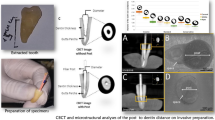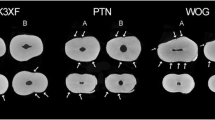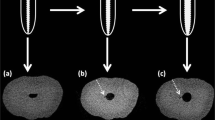Abstract
Objectives
The aim of this study was to detect microcracks and cuspal deflection in tooth crown following the application of temporary filling using microcomputed tomography (micro-CT).
Materials and methods
A mesio-occluso-distal cavity preparation was performed, followed by endodontic access cavity preparation and root canal shaping. Cavities were classified into two groups according to the type of temporary filling material used; Coltosol F (Coltene Whaledent) (Group I) and intermediate restorative material (IRM; Dentsply Sirona) (Group II). Micro-CT images before and after temporary filling material placement were obtained and then compared for the presence of microcracks. Microcracks considered in our data analysis were the new ones that were detected after temporary filling material placement. The mean number of new microcracks per tooth recorded for both groups were compared using Mann–Whitney U test. The number of teeth with new microcracks in both groups was compared by chi-square test. Repeated measures t test was conducted to observe the effect of temporary filling on the intercuspal distance (ICD). Also, the mean difference in the ICDs detected after temporary filling placement in both groups were compared by independent t test. The significance level was set at 5%.
Results
Eleven microcracks were detected in group I, whereas only three microcracks were observed in group II (p < 0.01). The mean numbers of new microcracks were 0.84 and 0.21 in group I and II, respectively (p < 0.01). There was no significant difference in the ICDs in group I (0.006±0.02 mm) and group II (0.018 ± 0.03 mm) (p > 0.26). Most of the microcracks were found in the dentin structure. The cavity’s box area was more affected by new microcracks, compared with the cavity’s coronal area. The new microcracks were mainly observed in the mesiodistal direction. No complete fractures were reported in our study.
Conclusions
Both temporary fillings induced microcracks; Coltosol F can induce more microcracks than IRM in premolar teeth after 1-week storage. Most of the microcracks were observed in the dentin structure of the cavity’s box area running mesiodistally.
Clinical relevance
The results indicated that the tested temporary fillings developed microcracks on the tooth crown with slight deflection of the cusps.



Similar content being viewed by others
References
Haapasalo M, Endal U, Zandi H, Coil JM (2005) Eradication of endodontic infection by instrumentation and irrigation solutions. Endod Topics 10:77–102. https://doi.org/10.1111/j.1601-1546.2005.00135.x
Tennert C, Eismann M, Goetz F, Woelber JP, Hellwig E, Polydorou O (2015) A temporary filling material used for coronal sealing during endodontic treatment may cause tooth fractures in large Class II cavities in vitro. Int Endod J 48:84–88. https://doi.org/10.1111/iej.12280
Capar ID, Saygili G, Ergun H, Gok T, Arslan H, Ertas H (2015) Effects of root canal preparation, various filling techniques and retreatment after filling on vertical root fracture and crack formation. Dent Traumatol 31:302–307. https://doi.org/10.1111/edt.12154
Jamleh A, Komabayashi T, Ebihara A et al (2015) Root surface strain during canal shaping and its influence on apical microcrack development: a preliminary investigation. Int Endod J 48:1103–1111. https://doi.org/10.1111/iej.12406
Tennert C, Fischer G, Vach K, Woelber JP, Hellwig E, Polydorou O (2016) A temporary filling material during endodontic treatment may cause tooth fractures in two-surface class II cavities in vitro. Clin Oral Investig 20:615–620. https://doi.org/10.1007/s00784-015-1543-z
Kahler W (2008) The cracked tooth conundrum: terminology, classification, diagnosis, and management. Am J Dent 21:275–282
Versiani MA, Souza E, De-Deus G (2015) Critical appraisal of studies on dentinal radicular microcracks in endodontics: methodological issues, contemporary concepts, and future perspectives. Endod Topics 33:87–157. https://doi.org/10.1111/etp.12091
Touré B, Faye B, Kane AW, Lo CM, Niang B, Boucher Y (2011) Analysis of reasons for extraction of endodontically treated teeth: a prospective study. J Endod 37:1512–1515. https://doi.org/10.1016/j.joen.2011.07.002
Wright M, Loushine J, Weller N, Kimbrough F, Waller J, Pashley H (2004) Identification of resected root-end dentinal cracks: a comparative study of transillumination and dyes. J Endod 30:712–715. https://doi.org/10.1097/01.DON.0000125876.26495.20
Paul A, Tamse A, Rosenberg E (2007) Cracked and broken teeth–definitions, differential diagnosis and treatment. Refuat Hapeh Vehashinayim 24:7–12
Imai K, Shimada Y, Sadr A, Sumi Y, Tagami J (2012) Noninvasive cross-sectional visualization of enamel cracks by optical coherence tomography in vitro. J Endod 38:1269–1274. https://doi.org/10.1016/j.joen.2012.05.008
De-Deus G, Belladonna F, Marins J et al (2016) On the causality between dentinal defects and root canal preparation: a micro-CT assessment. Braz Dent J 27:664–669. https://doi.org/10.1590/0103-6440201601002
Swanson K, Madison S (1987) An evaluation of coronal microleakage in endodontically treated teeth. Part I. Time period. J Endod 13:56–59. https://doi.org/10.1016/S0099-2399(87)80155-3
Ray H, Trope M (1995) Periapical status of endodontically treated teeth in relation to the technical quality of the root filling and the coronal restoration. Int Endod J 28:12–18. https://doi.org/10.1111/j.1365-2591.1995.tb00150.x
Deveaux E, Hildelbert P, Neut C, Boniface B, Romond C (1992) Bacterial microleakage of Cavit, IRM, and TERM. Oral Surg Oral Med Oral Pathol 74:634–642
Laustsen M, Munksgaard E, Reit C, Bjørndal L (2005) A temporary filling material may cause cusp deflection, infractions and fractures in endodontically treated teeth. Int Endod J. 38:653–657. https://doi.org/10.1111/j.1365-2591.2005.01003.x
Eskandarizade A, Torabi Parizi M, Parirokh M, Taheri A (2015) Cusp deflection, infraction and fracture in endodontically treated teeth filled with three temporary filling materials (in vitro). Journal of Dental Materials and Techniques 4:173–175. https://doi.org/10.22038/jdmt.2015.5176
Vail M, Steffel C (2006) Preference of temporary restorations and spacers: a survey of diplomats of the American Board of Endodontists. J Endod 32:513–515. https://doi.org/10.1016/j.joen.2005.11.009
Tames A, Ben-Amar A, Gover A (1982) Sealing properties of temporary filling materials used in endodontics. J Endod 8:322–325. https://doi.org/10.1016/S0099-2399(82)80282-3
Chohayeb A, Bassiouny M (1985) Sealing ability of intermediate restoratives used in endodontics. J Endod 11:241–244. https://doi.org/10.1016/S0099-2399(85)80178-3
Pereira J, McDonald A, Petrie A, Knowles J (2013) Effect of cavity design on tooth surface strain. J Prosthet Dent 110:369–375. https://doi.org/10.1016/j.prosdent.2013.08.004
Kobayashi C, Suda H (2007) Swelling of dentin by hydration. 13th Biennial Congress of the European Society of Endodontics Abstract Book 83
Rivera EM, and Walton RE 2008 “Cracking the cracked tooth code: detection and treatment of various longitudinal tooth fractures,” American Association of Endodontists Colleagues for Excellence, Newsletter, Summer.
Carvalho R, Fernandes C, Villanueva R, Wang L, Pashley DH (2001) Tensile strength of human dentin as a function of tubule orientation and density. J Adhes Dent 3:309–314
Mannocci F, Pilecki P, Bertelli E, Watson TF (2004) Density of dentinal tubules affects the tensile strength of root dentin. Dent Mater 20:293–296. https://doi.org/10.1016/S0109-5641(03)00106-4
Russell A, Chandler N, Hauman C, Siddiqui A, Tompkins G (2013) The butterfly effect: an investigation of sectioned roots. J Endod 39:208–210. https://doi.org/10.1016/j.joen.2012.09.016
Ratcliff S, Becker I, Quinn L (2001) Type and incidence of cracks in posterior teeth. J Prosthet Dent 86:168–172. https://doi.org/10.1067/mpr.2001.116578
Seo D, Yi Y, Shin S, Park J (2012) Analysis of factors associated with cracked teeth. J Endod 38:288–292. https://doi.org/10.1016/j.joen.2011.11.017
Ricucci D, Siqueira J, Loghin S, Berman L (2015) The cracked tooth: histopathologic and histobacteriologic aspects. J Endod 41:343–352. https://doi.org/10.1016/j.joen.2014.09.021
Barreto M, Moraes Rdo A, Rosa R et al (2012) Vertical root fractures and dentin defects: effects of root canal preparation, filling, and mechanical cycling. J Endod 38:1135–1139. https://doi.org/10.1016/j.joen.2012.05.002
PradeepKumar A, Shemesh H, Chang J et al (2017) Preexisting dentinal microcracks in nonendodontically treated teeth: an ex vivo micro-computed tomographic analysis. J Endod 43:896–900. https://doi.org/10.1016/j.joen.2017.01.026
De-Deus G, Belladonna F, Souza E et al (2015) Micro–computed tomographic assessment on the effect of ProTaper Next and Twisted File Adaptive systems on dentinal cracks. J Endod 41:1116–1119. https://doi.org/10.1016/j.joen.2015.02.012
Hiatt W (1973) Incomplete crown-root fracture in pulpal-periodontal disease. J Periodontol 44:369–379. https://doi.org/10.1902/jop.1973.44.6.369
Shen Y, Stojicic S, Haapasalo M (2011) Antimicrobial efficacy of chlorhexidine against bacteria in biofilms at different stages of development. J Endod 37:657–661. https://doi.org/10.1016/j.joen.2011.02.007
Berman L, Kuttler S (2010) Fracture necrosis: diagnosis, prognosis assessment, and treatment recommendations. J Endod 36:442–446. https://doi.org/10.1016/j.joen.2009.12.018
Funding
This work was supported by the King Abdullah International Medical Center RC17/189/R.
Author information
Authors and Affiliations
Corresponding author
Ethics declarations
The study protocol was approved by an Ethical Committee Board.
Conflict of Interest
The authors declare that they have no conflict of interest.
Ethical approval
This article does not contain any studies with human participants or animals performed by any of the authors
Informed Consent
For this type of study, formal consent is not required
Additional information
Publisher’s note
Springer Nature remains neutral with regard to jurisdictional claims in published maps and institutional affiliations.
Rights and permissions
About this article
Cite this article
Jamleh, A., Mansour, A., Taqi, D. et al. Microcomputed tomography assessment of microcracks following temporary filling placement. Clin Oral Invest 24, 1387–1393 (2020). https://doi.org/10.1007/s00784-019-03093-7
Received:
Accepted:
Published:
Issue Date:
DOI: https://doi.org/10.1007/s00784-019-03093-7




